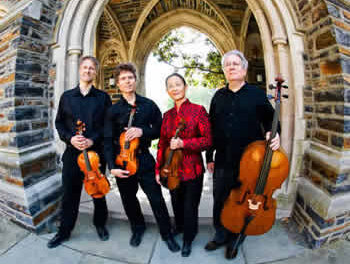Tatiana Gorbunova, an accomplished pianist in both Russia and the United States and currently based in Florida, performed an excellent program of music by contemporary composers in Carswell Recital Hall at Meredith College. The composure and ease with which Gorbunova played masked the extreme difficulty of her repertoire.
First on the program was a selection from György Ligeti’s set of etudes – “En Suspens,” Book 2, No. 11. This contemporary classical take on a typical etude features sections where the meter of each hand is essentially different. This results in a type of two-against-three pattern, adding complexity to an abstract melody. There is an innate lack of consonance in this etude and an unresolved ending, but Gorbunova still performed it gracefully.
Les soirées de Nazelles, finished in 1936 by Francis Poulenc, is a curious collection of portraits inspired by his own friends, all based loosely on the same theme, sometimes flowing together and sometimes directly contrasting each other. The portraits are preceded by a stately and introductory Préambule. Then, “Le comble de la distinction,” lively and expressive, is followed by the more romantic and waltz-like “Le coeur sur la main” (“The heart on hand”). The third and fourth portraits are more contrasting to the previous ones. Gorbunova expertly handled the rapid texture changes, moving from a proud and strong presto tempo to more suspenseful echoes, played with rubato. The last portrait, “L’alerte vieillesse” (“The old warning”), is dance-like but mysterious, entering with fast and rhythmic pulsing of the keys. Another featured texture is the simultaneous contrast between staccato and legato phrases. This contrast is not easy to achieve fully, but Gorbunova made this seem effortless. The last of Poulenc’s portraits leads directly to the Cadence and Final, both grand continuations of the original theme. The Final seems to have had the fastest tempo yet, but it is contrasted by a softer, lovely melody that occurs, made bittersweet with dissonance. After statements of a rising and falling unison melody, the piece ends strongly with a sudden final cadence.
Rachmaninoff’s Piano Sonata No. 1, in D minor, Op. 28, is sometimes overshadowed by his Piano Sonata No. 2 (Op. 36), but here it was the highlight of the concert. Composed in Dresden in 1908, this sonata was originally loosely based on the tragedy Faust; some of those dramatic influences remain. The first movement, Allegro moderato, introduces the proud theme, which increases in complexity with each repetition. Sudden tempo changes lead to the occurrence of multiple melodies simultaneously, a complex web played discerningly by Gorbunova. The texture of a solemn melody supported by a backdrop of flowing notes was particularly beautiful to experience. To conclude this movement, triumphantly bursting chords give way to shimmering treble patterns, ending with a calm cadence.
Following the form of a classical sonata, the Lento movement is slow and romantic, with a meditative and slightly mournful melody. The introduction of slight dissonances give the texture a mysterious edge, followed by runs up and down the keys that resembled the slight motion of calm waves. A notable technique that Gorbunova brought to this movement was her sense of place and awareness of the sound. For instance, at one point, she paused long enough to let the sound fade away, but began again precisely before the sound died completely. Of course, the exception to this was the end of the Lento movement, where Gorbunova let the last notes fade completely. This dramatic touch was very effective.
The final movement, Allegro molto, is solidly energetic from its very first chord. Melodic phrases crescendo and decrescendo rapidly over a syncopated rumbling bass pattern. Both texture and meter are constantly changing, punctuated by rhythmic and grand cadences. With each rise and fall of the volume, the energy and tension builds. Gorbunova’s performance of the last several minutes was especially mesmerizing. Breathless transitions between keys and textures were seamless as well. Overall, the Allegro motto movement was a fantastic conclusion to both the sonata and a very worthwhile performance.











